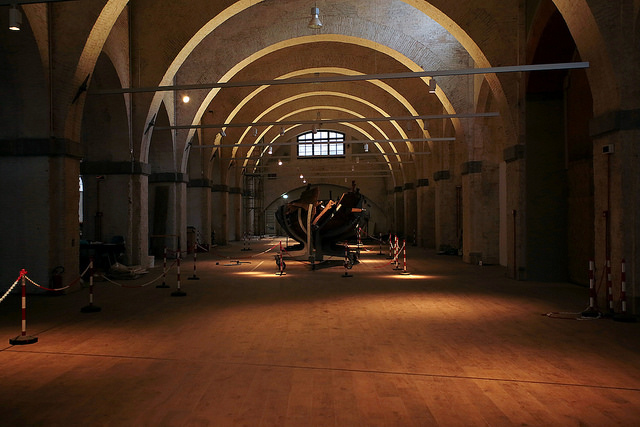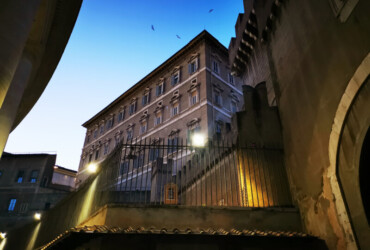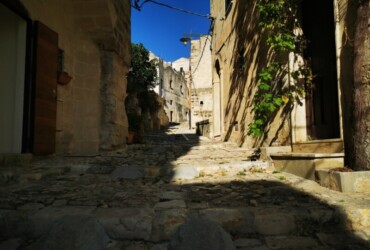Let’s go back to Pisa, to discover it again by going beyond Piazza dei Miracoli and its beauty. We begin the tour from the Fortilizio “La Cittadella” or, better to say, from the complex of the Guelph Fortilizio.
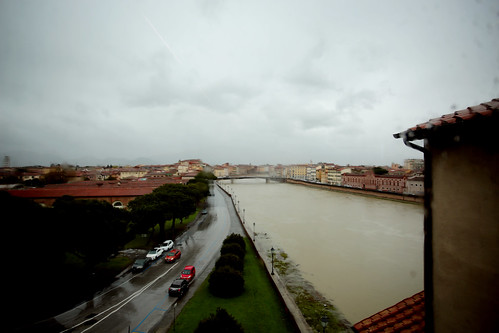 The complex was built to connect the Degazia gate to the Stampace bastion. The complex is made up of several buildings: the Porta Degazia, the door with a drawbridge, the fortified castle, the Guelph Tower and the side building from which the ancient bridge sea (“Pons Maris”) and dates back to the end of the 13th century. The tower we visited, the Guelph Tower, was built during the first Florentine domination (1406) when the whole area of the Arsenals of Pisa was restored. The name? It was chosen because in perfect contrast with the Ghibelline Tower (another tower in the area of the arsenals erected in 1290 and then,
The complex was built to connect the Degazia gate to the Stampace bastion. The complex is made up of several buildings: the Porta Degazia, the door with a drawbridge, the fortified castle, the Guelph Tower and the side building from which the ancient bridge sea (“Pons Maris”) and dates back to the end of the 13th century. The tower we visited, the Guelph Tower, was built during the first Florentine domination (1406) when the whole area of the Arsenals of Pisa was restored. The name? It was chosen because in perfect contrast with the Ghibelline Tower (another tower in the area of the arsenals erected in 1290 and then,
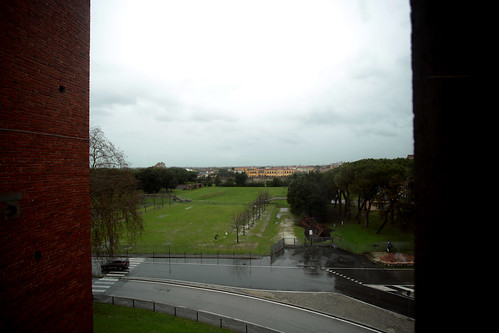 unfortunately, destroyed). In 1944 the area suffered severe damage due to the war and the Guelph tower and portion of the fortress were rebuilt after the war (1956). Inside there are coats of arms of various buildings in Pisa: some were families of the Capitani and Florentine Commissaries who succeeded one another in the city government (one was from Lutozzo Masi, general commissioner from 1644 to 1646). The municipality has recently renovated the whole complex. The Guelph Tower has been the object of extraordinary maintenance to accommodate the visitors who want to see from a high point the area of the ancient Terzana and in general from the city of Pisa.
unfortunately, destroyed). In 1944 the area suffered severe damage due to the war and the Guelph tower and portion of the fortress were rebuilt after the war (1956). Inside there are coats of arms of various buildings in Pisa: some were families of the Capitani and Florentine Commissaries who succeeded one another in the city government (one was from Lutozzo Masi, general commissioner from 1644 to 1646). The municipality has recently renovated the whole complex. The Guelph Tower has been the object of extraordinary maintenance to accommodate the visitors who want to see from a high point the area of the ancient Terzana and in general from the city of Pisa.
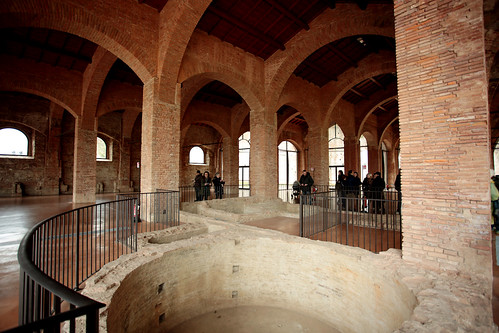 Even the Republican Arsenals, the second stop on our Sunday tour, have been subject to restoration and recovery in recent years: part of the historical memories of the city, have been reported to shine in all their beauty. We know that the construction of the tersana (western side of the city walls) began between 1159 and 1161 and along the river were the “Domus galearum”, porticos sheds for the admission of the galleys (it seems they were between forty and eighty boats).
Even the Republican Arsenals, the second stop on our Sunday tour, have been subject to restoration and recovery in recent years: part of the historical memories of the city, have been reported to shine in all their beauty. We know that the construction of the tersana (western side of the city walls) began between 1159 and 1161 and along the river were the “Domus galearum”, porticos sheds for the admission of the galleys (it seems they were between forty and eighty boats).
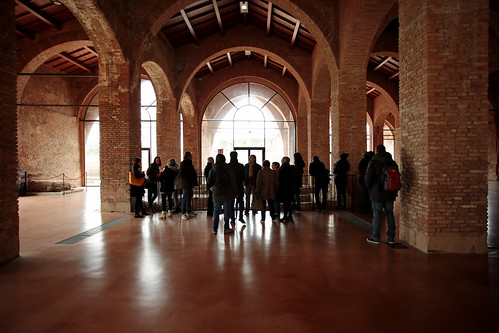 The structure of the arsenal, as you can see it today (renovated), was built between 1329 and 1338 for the housing of jail or several smaller boats. The structure is, in itself, very particular already starting from its structure: from the rhomboidal shape and about 40 meters side of the aisles, the front elevations are inclined about 50 ° to the longitudinal pillars to facilitate the entrance of boats on the dry dock.
The structure of the arsenal, as you can see it today (renovated), was built between 1329 and 1338 for the housing of jail or several smaller boats. The structure is, in itself, very particular already starting from its structure: from the rhomboidal shape and about 40 meters side of the aisles, the front elevations are inclined about 50 ° to the longitudinal pillars to facilitate the entrance of boats on the dry dock.
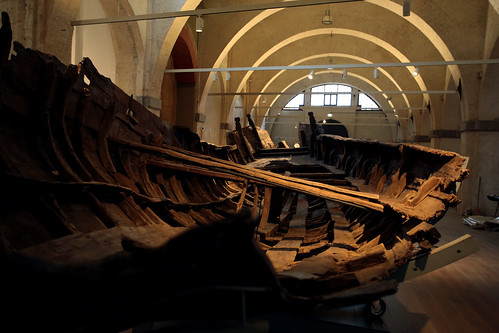 To conclude our tour of the city we went to discover the Medici Arsenals, which host the Pisa Ancient Ships Museum. The structure is located on Lungarno Ranieri Simonelli, and we can define it as one of the most important and great archaeological expositions, on 30 boats from the Roman period (of which 11 are intact), dating back to the III century BC and VII AD. From October 2017, the Nave Alkedo (or “Nave C”) is visible inside the museum: a large rowing boat of the Augustan age, over 22 meters long, preserved practically intact except for part of the stern. His particularity? Although it was a pleasure craft, its form was that of warships. It was possible to reproduce the original colour thanks to traces of colour remained over time (there is a full-size reconstruction of the boat). The first ashes were found in 1998 during the construction of the railway station of San Rossore: this led, of course, to the blocking of works for the station and opened the excavation and restoration site.
To conclude our tour of the city we went to discover the Medici Arsenals, which host the Pisa Ancient Ships Museum. The structure is located on Lungarno Ranieri Simonelli, and we can define it as one of the most important and great archaeological expositions, on 30 boats from the Roman period (of which 11 are intact), dating back to the III century BC and VII AD. From October 2017, the Nave Alkedo (or “Nave C”) is visible inside the museum: a large rowing boat of the Augustan age, over 22 meters long, preserved practically intact except for part of the stern. His particularity? Although it was a pleasure craft, its form was that of warships. It was possible to reproduce the original colour thanks to traces of colour remained over time (there is a full-size reconstruction of the boat). The first ashes were found in 1998 during the construction of the railway station of San Rossore: this led, of course, to the blocking of works for the station and opened the excavation and restoration site.
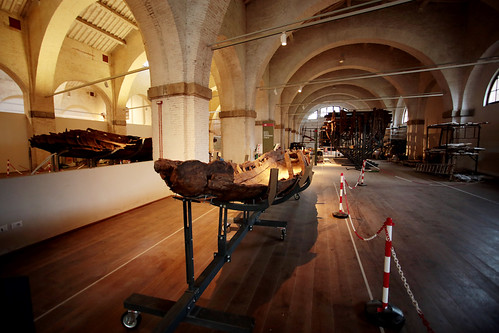 These excavations brought to light the history of the seafaring past of Pisa, which included businesses and sailors, navigations and routes, daily life on board and shipwrecks. The first two rooms to be open to the public are Room IV, where the ship A (18 meters long and dating back to the 2nd century AD) is exposed and the V hall, where all the restored ships will be exhibited: from war, trade, open sea and river. At the time of our visit, we were able to see, in this room, the Nave F (2nd century AD), a small riverboat in the shape of a canoe. The hull is deformed because the rowers were only on one side, like the gondolas; the Ship I (of the IV-V century AD) is a flat-bottomed ferry entirely made of oak and covered on the outside by iron-clad bands to protect the hull from shallow waters. The Ship D (VI century AD) will be visible on a large metal structure, which will support this important vessel, 13 meters long and more than 4 meters wide: a river ship used for transporting sand, pulled by a pair of horses.
These excavations brought to light the history of the seafaring past of Pisa, which included businesses and sailors, navigations and routes, daily life on board and shipwrecks. The first two rooms to be open to the public are Room IV, where the ship A (18 meters long and dating back to the 2nd century AD) is exposed and the V hall, where all the restored ships will be exhibited: from war, trade, open sea and river. At the time of our visit, we were able to see, in this room, the Nave F (2nd century AD), a small riverboat in the shape of a canoe. The hull is deformed because the rowers were only on one side, like the gondolas; the Ship I (of the IV-V century AD) is a flat-bottomed ferry entirely made of oak and covered on the outside by iron-clad bands to protect the hull from shallow waters. The Ship D (VI century AD) will be visible on a large metal structure, which will support this important vessel, 13 meters long and more than 4 meters wide: a river ship used for transporting sand, pulled by a pair of horses.
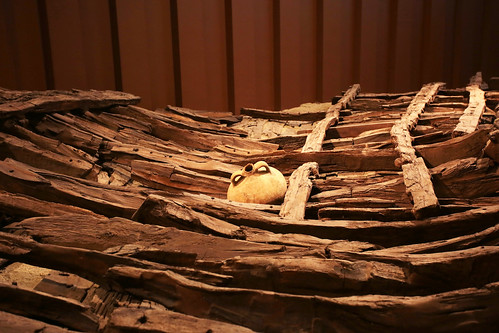 Room IV is dedicated to the construction technique of ships and tells the story of the excavation site, how it was expanded and equipped for this discovery so unique and that no one would have expected!
Room IV is dedicated to the construction technique of ships and tells the story of the excavation site, how it was expanded and equipped for this discovery so unique and that no one would have expected!
The museum’s rooms will be 8 in total. The Medicean Arsenals were considered the most suitable place for the preparation of this museum: built in the second half of the sixteenth century by the will of Cosimo I, the Arsenals are formed by a series of brick sheds, initially open, decorated on the facade towards the Arno by marble masks, coats of arms and inscriptions reminiscent of the naval victories of the Order of the Knights of St. Stephen. For all useful information like timetables, prices and guided tours, I refer you to the museum official website.
I still thank all the sponsors of these weekends in Pisa:
the Pisa municipality, for its patronage;
the Ship Museum and the Opera of the Primaziale Pisana, which allowed us to visit some beautiful places (the monuments of Piazza dei Miracoli and the Museum of the Ancient Ships of Pisa);
I also thank:
PisaGuide.com for letting us discover, thanks to a highly prepared guide, the splendour of Piazza dei Miracoli;
Regarding the restaurants:
Spaghetteria Ir Tegame
Typical Restaurant the Tourist
Osteria del Violino for having refreshed us after the long walks of our Pisan weekend.
A thank you also goes to the Grand Hotel Duomo, a stone’s throw from Piazza dei Miracoli, which as a partner hotel has hosted us for the night.
#aspassoperpisa: Fortress, Arsenals and Ship Museum
